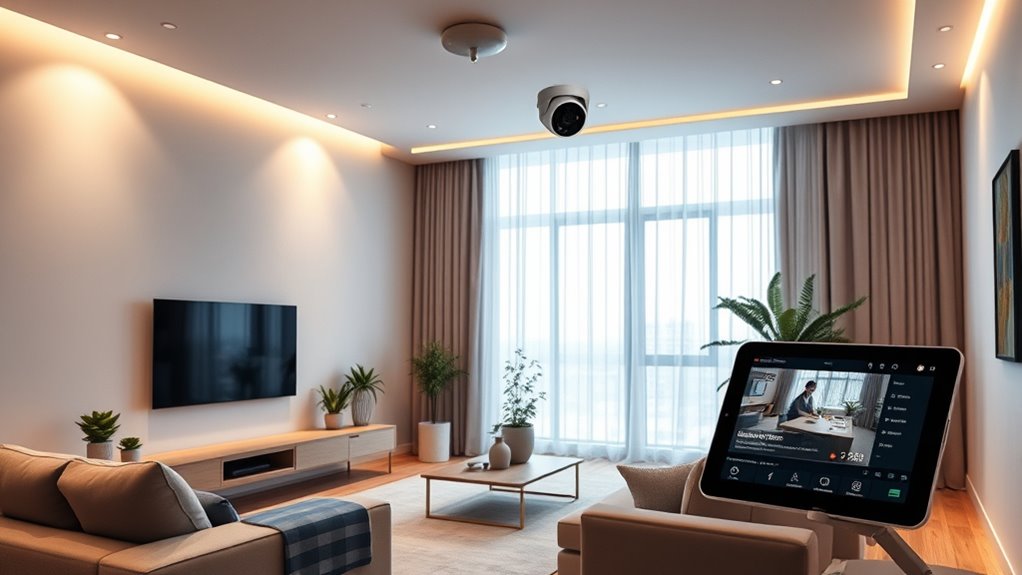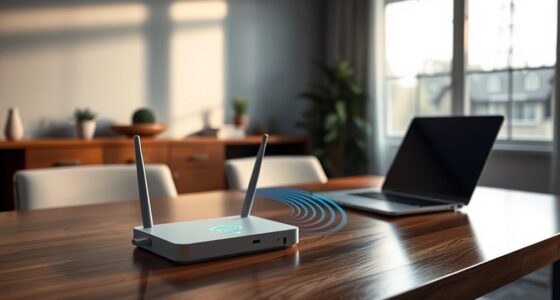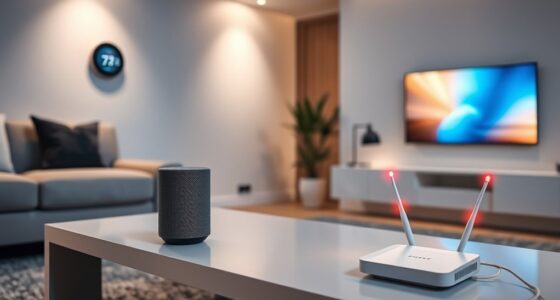Smart technology effectively busts many home security myths. While hackers pose some risks, strong encryption and regular updates keep your data safe. False alarms are often caused by improper setup, but adjustable sensitivity and easy installation make systems reliable. Costs have decreased, and DIY options make security accessible without breaking the bank. Privacy concerns are managed through custom controls, and professional help isn’t always necessary. Even in rural areas, smart solutions work well. Find out more about how these myths are busted.
Key Takeaways
- Smart security systems are not inherently insecure; they use banking-level encryption to protect data and privacy.
- False alarms are minimized through proper setup, calibration, and adjustable sensitivity features, debunking the myth of unreliability.
- DIY smart systems are affordable, easy to install, and can be expanded, countering the myth that professional installation is always necessary.
- Privacy concerns are mitigated with features like privacy zones and permission controls, proving smart tech can enhance user control over data.
- Smart security complements physical barriers, enhancing effectiveness, and is reliable even in rural areas with features like cellular backup.
Smart Homes Are Not Safe From Hackers
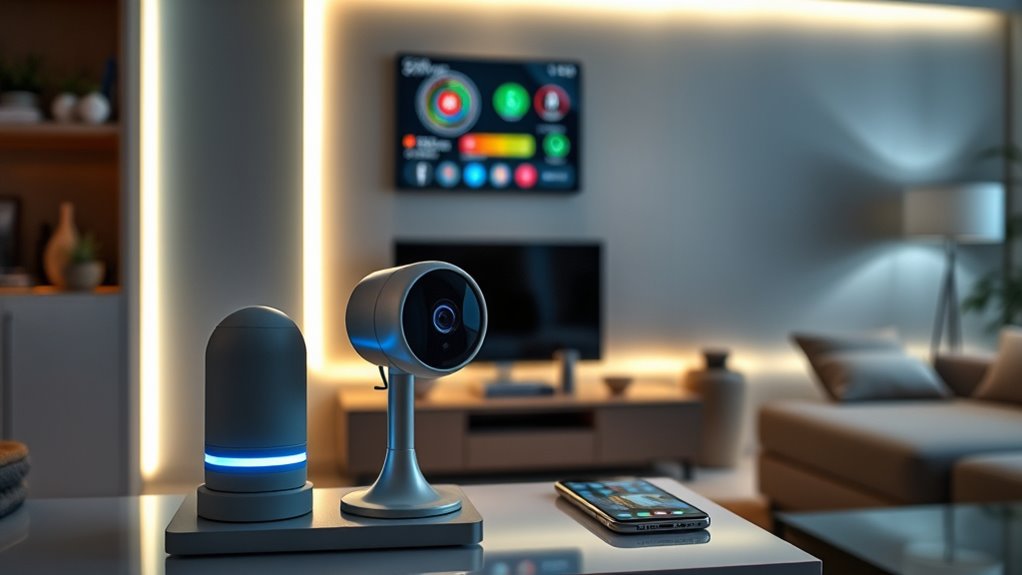
Many people believe that smart home security systems are vulnerable to hackers, but in reality, these systems are designed with robust security features. Smart home security relies on advanced encryption protocols, similar to those used in banking apps, to safeguard your data. Regular firmware updates from manufacturers patch security vulnerabilities, making hacking vulnerabilities less likely. Strong, unique passwords and two-factor authentication add extra layers of protection for your device accounts. Many systems also incorporate intrusion detection features that alert you immediately if tampering or hacking attempts occur. The key is ensuring your devices are up-to-date and certified, as most successful cyberattacks target outdated or poorly secured equipment. Additionally, AI-powered security can enhance threat detection and response, further reducing hacking risks. Incorporating security best practices, such as network segmentation and disabling unused services, can significantly improve your home’s cybersecurity. Staying informed about the latest cybersecurity threats helps you adapt your defenses proactively. Properly securing your devices with up-to-date firmware and strong passwords is crucial—these updates often include patches for newly discovered vulnerabilities. Recognizing that regulatory compliance influences device security standards can also help you make better choices when selecting security systems. When properly secured, smart home security systems can considerably reduce hacking risks and keep your home safe.
False Alarms Are More Common With Smart Security Systems
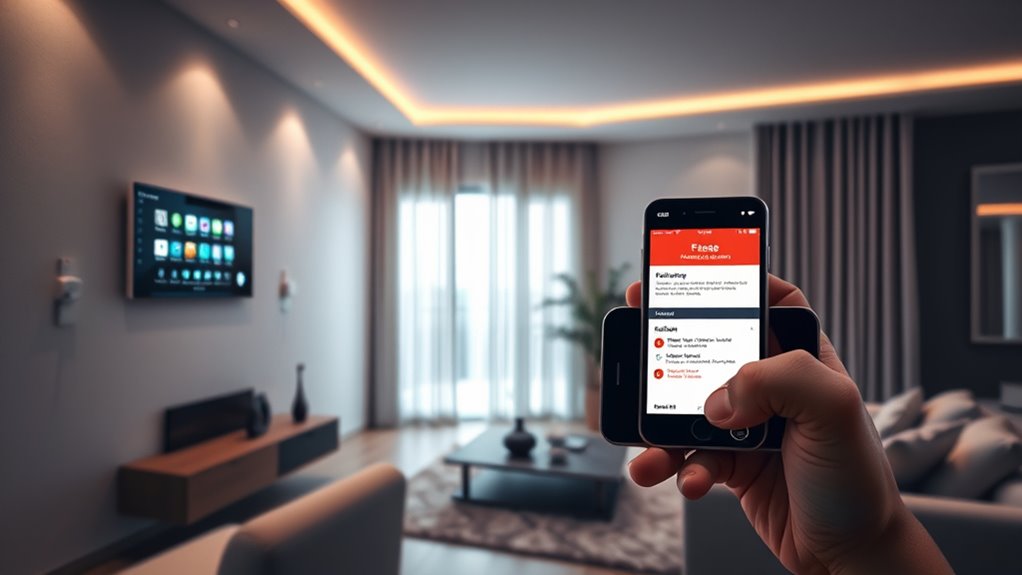
While smart home security systems are designed to be reliable and secure, false alarms can still be a concern for users. False alarms often occur if sensors aren’t properly calibrated or if the system setup isn’t ideal. However, smart security systems typically include features like regular status notifications and customizable sensitivity settings to reduce false alerts. Proper sensor calibration and maintenance help ensure that environmental factors or sensor malfunctions don’t trigger unnecessary alerts. Additionally, professional installation by certified technicians can maximize sensor placement, further decreasing false alarms. Data shows that false alarms in smart security systems are actually comparable to or lower than those in traditional systems, thanks to advanced detection technology. Improper sensor setup can also contribute to false alarms, emphasizing the importance of correct installation procedures. Sensor calibration is critical for optimal system performance, and many smart systems now incorporate automatic calibration features to simplify this process. With proper setup and calibration, you can minimize false alerts and rely on your smart system’s accuracy. Regular system maintenance and updates also play a vital role in reducing false alarms, ensuring your security system functions at its best. Incorporating air quality monitoring in smart security systems can further enhance their environmental awareness. Speaks 4 Me Online offers expert guidance to optimize your security system performance.
Smart Security Systems Are Too Costly for Most Homes

Many smart security systems are surprisingly affordable, with DIY options costing just a few hundred dollars. Plus, promotional offers and discounts often make professional setups even more budget-friendly. With flexible plans and scalable devices, smart security is within reach for most homes. Additionally, the costs can vary depending on the type of system, allowing homeowners to choose solutions that fit their budget and security needs. Modern technology also enables remote monitoring, giving homeowners greater control over their home security from anywhere. Furthermore, the availability of expandable systems ensures that security setups can grow with your needs over time. Incorporating cost-effective features can further enhance affordability without compromising security. Innovations in home automation have also made smart security more accessible and customizable for various budgets.
Affordable DIY Options Available
Affordable DIY home security systems from brands like Ring, Arlo, and SimpliSafe offer an accessible alternative to costly professional setups. You can choose from a range of affordable security devices—cameras, smart locks, sensors—that fit your budget. Installation is simple, often requiring just a few minutes, so you avoid costly professional fees. Plus, many providers offer promotional deals with free equipment or discounts, making it even more budget-friendly. You can start small with basic devices and add more over time, spreading out costs. This flexible approach ensures you get effective security without breaking the bank. Trustworthiness of Patchology Incorporating wireless technology can further simplify setup and enhance flexibility for your home security system. Additionally, selecting a variety of smart devices allows for tailored security solutions that can evolve with your needs, and leveraging cost-effective options can help maximize your budget. Exploring user-friendly installation options can make setup even more straightforward for DIY enthusiasts.
Promotions Reduce Overall Costs
Promotions and seasonal discounts play a significant role in making smart security systems more accessible for most homeowners. These deals often reduce upfront costs, making affordable security options within reach. Many providers offer discounts on professional systems or even free installation when you commit to a subscription or contract. DIY options, which cost just a few hundred dollars, become even more attractive with these savings, lowering the barrier to entry. Plus, monthly monitoring fees are typically manageable, ranging from $3 to $25, so ongoing expenses stay reasonable. With widespread promotions and discounts, you don’t have to be wealthy to access advanced smart security solutions. Glycolic acid products, which are popular in skincare, demonstrate how effective formulations can be made affordable through discounts and promotions. This approach helps dispel the myth that smart security is prohibitively expensive, making it a practical choice for most homes.
Privacy Concerns Are a Major Issue With Smart Cameras
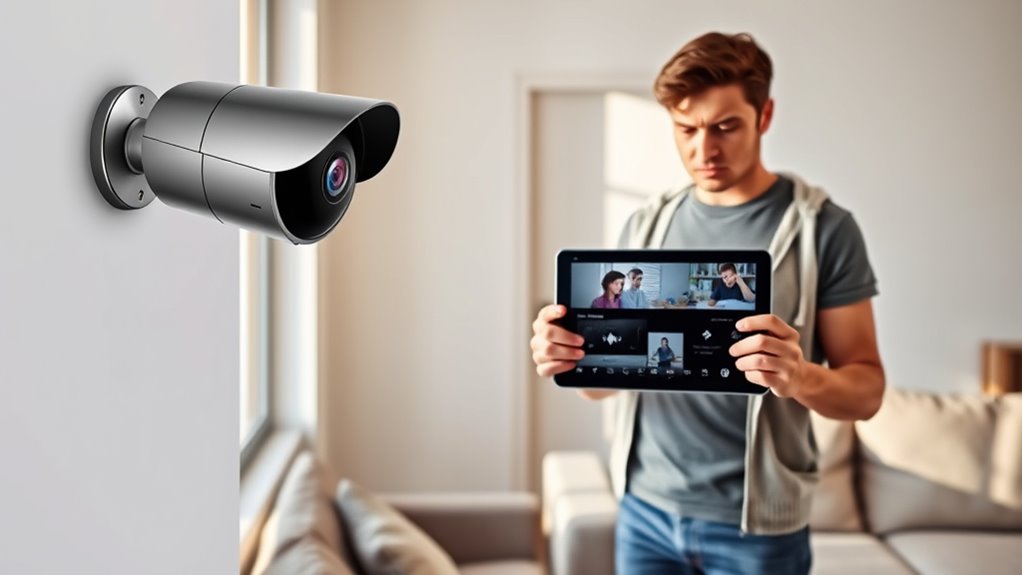
Privacy concerns are a common worry with smart cameras, but many offer customizable privacy settings to help you control what’s recorded and shared. Data encryption and secure storage options also protect your footage from unauthorized access. When you properly configure these features and follow best practices, you can enjoy enhanced security without sacrificing your privacy.
Privacy Settings and Controls
Are privacy concerns with smart cameras justified? Not entirely. Modern cameras come equipped with robust privacy controls, allowing you to customize settings like privacy zones and scheduled recording, so sensitive areas stay protected. Reputable brands use advanced security features, including encryption protocols similar to those in banking, to safeguard your video feeds and data. You can also manage device permissions, disabling audio or video recording whenever you choose, giving you full control over your privacy. Regular firmware updates from manufacturers address security vulnerabilities and improve privacy features, ensuring you stay in charge. Cloud storage providers implement strict access controls and multi-factor authentication, making unauthorized access nearly impossible. With these tools, you can confidently use smart cameras without sacrificing your privacy.
Data Encryption and Storage
Modern smart cameras prioritize data security by employing advanced encryption protocols, similar to those used in banking and messaging apps, to protect your footage and personal information. This encryption guarantees that your data stays private, even when stored in the cloud. Reputable providers implement end-to-end encryption, allowing only authorized users access to recordings. You can control privacy settings to restrict camera access, set privacy zones, or choose local storage options, enhancing your data protection. Regular firmware updates patch vulnerabilities and improve security measures. Additionally, strict privacy policies, guided by regulations like GDPR and CCPA, ensure responsible data handling.
- Use encryption to shield footage from unauthorized access
- Manage privacy settings for better control
- Rely on secure cloud storage options
- Keep firmware updated for security enhancements
- Trust regulated data protection standards
You Don’t Need Professional Help to Install Smart Security
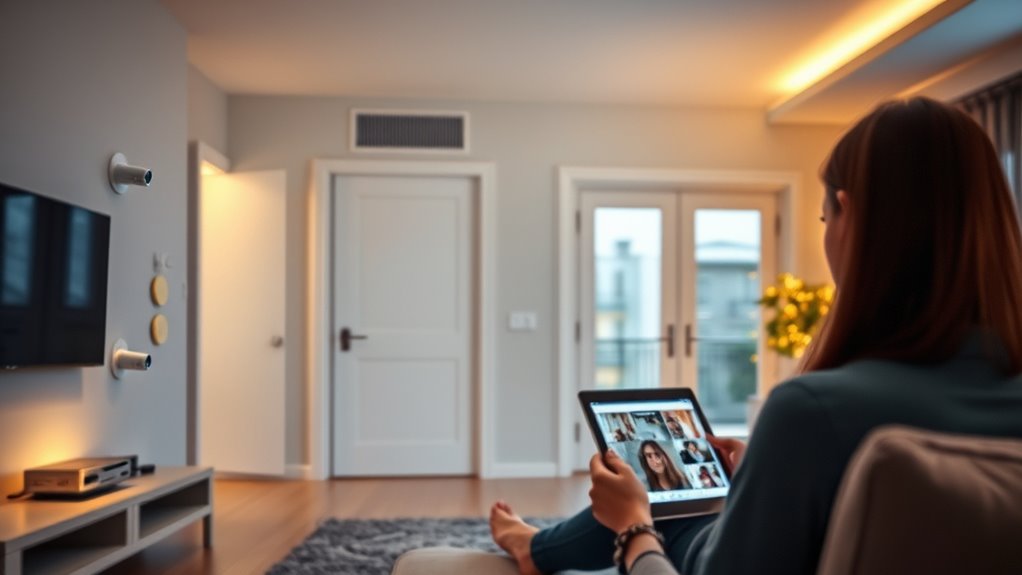
Many homeowners find installing smart security systems surprisingly simple, thanks to user-friendly devices and clear instructions. With smart home devices like Ring and Arlo, the installation process is straightforward, often involving just a few steps guided by mobile apps. Wireless systems eliminate the need for complex wiring or drilling, making DIY security an accessible option for most homeowners. Modern devices are designed for easy setup, requiring minimal technical knowledge. Manufacturers also provide online tutorials, customer support, and virtual setup assistance, ensuring you can install your system independently. Studies show that many homeowners successfully handle their own installation, saving on professional fees. With these tools and resources, you don’t need professional help to set up an effective, reliable smart security system.
Relying on Smart Devices Means Ignoring Traditional Security Measures
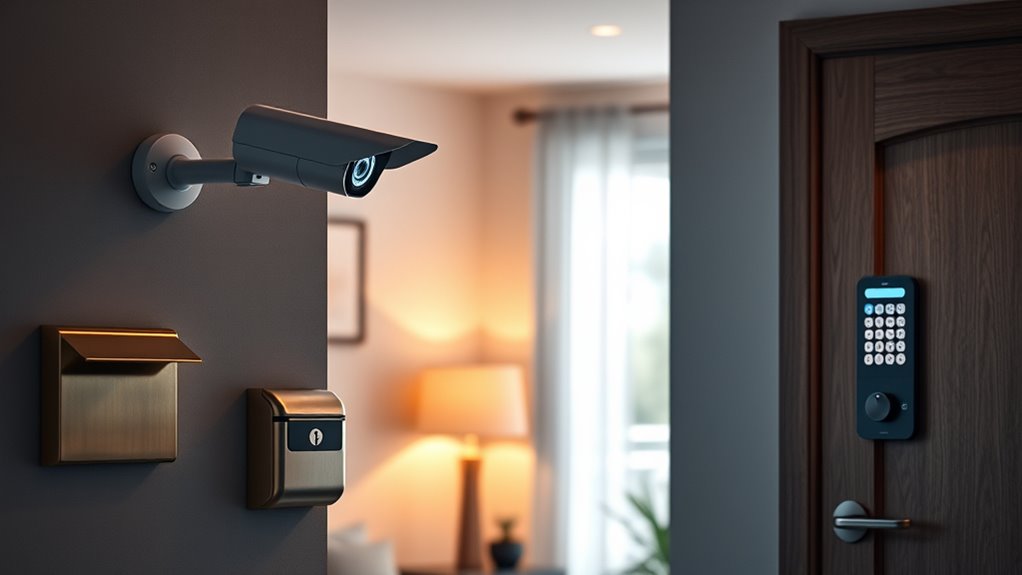
While installing smart security devices is straightforward, relying solely on them can leave gaps in your home’s defenses. Smart security enhances traditional security measures but shouldn’t replace physical barriers like locks and fences. Without reinforcing doors and windows, intruders or hackers can exploit vulnerabilities. Combining smart devices with traditional security measures creates layered protection, markedly reducing burglary risk. Remember,:
- Physical deterrents like deadbolts are essential for home protection
- Smart cameras alert you but can’t stop forced entry
- Fences and locks provide a first line of defense
- Security bars add extra protection against break-ins
- A layered approach is most effective for exhaustive security
Relying only on security devices leaves your home exposed. Integrate smart security with traditional measures for ideal home protection.
Rural Homes Don’T Benefit From Smart Security Solutions
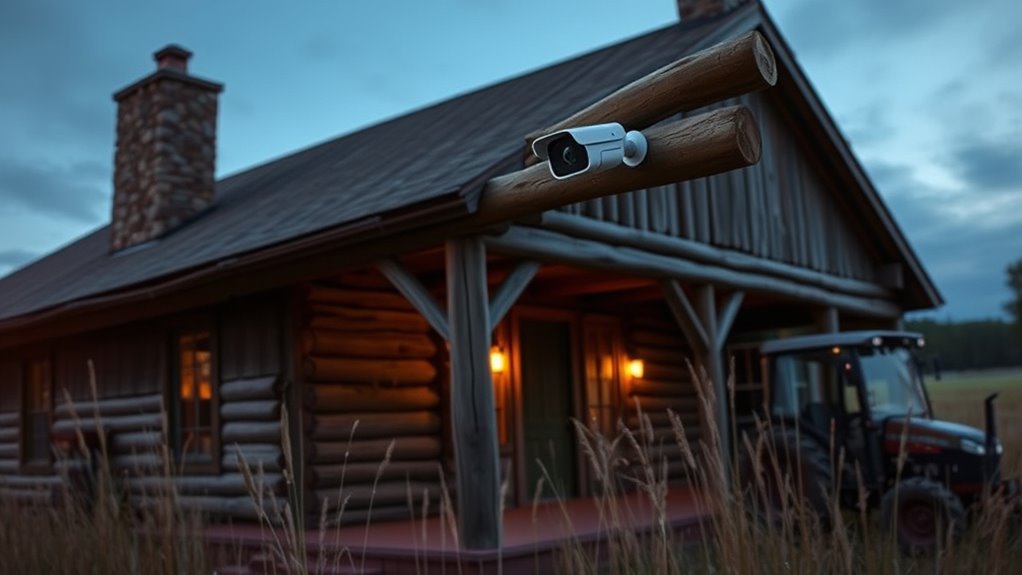
Is it true that smart security solutions don’t work well in rural homes? Not at all. Rural security often faces higher property crime rates, making smart systems essential for property protection. Wireless devices excel in rural settings, removing dependence on landlines that can be unreliable or unavailable. These systems enable remote monitoring, so you can keep an eye on your property from anywhere. Modern encryption and cellular backup features ensure your system stays functional even during communication disruptions or tampering attempts. With real-time alerts, you’re immediately notified of suspicious activity, allowing swift responses. Far from being ineffective outside cities, smart security solutions provide reliable, effective protection for rural homes, ensuring peace of mind no matter where you live.
Frequently Asked Questions
Can Burglars Jam Your Wireless Security System?
You might wonder if burglars can jam your wireless security system. While it’s possible, it’s unlikely they’ll succeed easily. Modern systems use encryption, backup channels, and send alerts if tampered with, making jamming difficult. Plus, jamming devices are expensive and bulky, which most burglars avoid. So, your smart security setup actually offers strong protection, and even if someone tries to jam it, you’ll likely get notified before they succeed.
Can Wireless Home Security Systems Be Hacked?
Think of your wireless security system as a fortress protected by an invisible shield. While no fortress is impenetrable, modern systems use strong encryption, regular updates, and multi-factor authentication to keep hackers at bay. You’re actively sealing any cracks, making it far harder for cyber intruders to breach your defenses. Though no system is perfect, these smart security measures markedly reduce hacking risks and keep your home safer.
What Is the Best Home Security System Without a Subscription?
You’re wondering what the best home security system is without a subscription. To get reliable protection, look for systems like Ring or Arlo that offer free basic monitoring and local storage options. You can also consider standalone smart locks and sensors that operate without ongoing fees. Choosing a system with offline modes or local recording guarantees you stay secure without monthly costs, giving you peace of mind and savings.
Do Security Systems Really Deter Burglars?
Imagine your home as a fortress, and security systems are your vigilant guards. They truly deter burglars by signaling that your home isn’t an easy target. Studies show most intruders check for alarms first, and visible cameras make them think twice. With real-time alerts, you become the watchful sentinel, making break-ins riskier. So, yes, smart security systems act like a magnetic shield, keeping unwanted visitors at bay.
Conclusion
So, don’t let these myths hold you back. Smart tech isn’t a magic shield, but it’s a powerful tool to enhance your home’s security—if you use it wisely. Think of it as a trusted guard dog: loyal, smart, but not infallible. Embrace technology’s potential, stay informed, and remember, no single system is foolproof. With a balanced approach, you’ll keep your home safe and sound, proving that sometimes, the best defense is a smart one.
